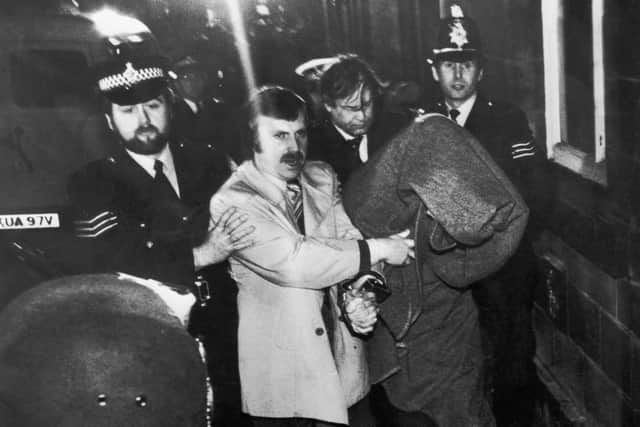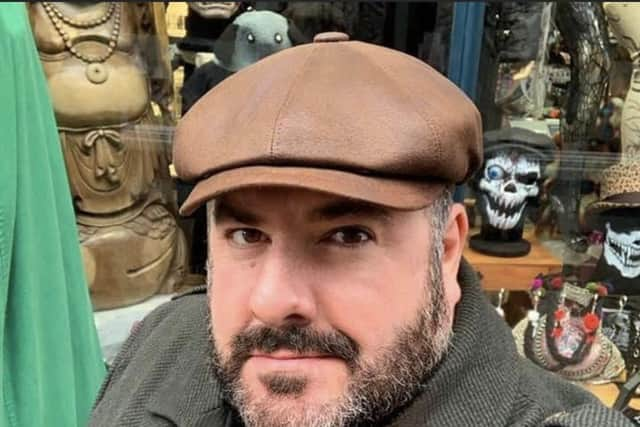Convicting the Yorkshire Ripper: New book reveals how Peter Sutcliffe almost avoided 'trial of the century'
More than 40 years on, the trial of Peter Sutcliffe still looms large in the public consciousness as the man infamously dubbed ‘The Yorkshire Ripper’ was eventually convicted of 13 murders and seven attempted murders.
Now a new book, Convicting The Yorkshire Ripper, by author Richard Charles Cobb, tells the story of the dramatic court case – and how close Sutcliffe came to avoiding trial through his attempts to blame his crimes on insanity.
Advertisement
Hide AdAdvertisement
Hide AdCobb, whose book is a sequel to 2019’s On the Trail of the Yorkshire Ripper, has dedicated the new volume to Justice Leslie Boreham, the judge who ensured the case went ahead by blocking an intended plea deal agreed by the prosecution and defence based on Sutcliffe’s supposed mental illness.


Cobb says: “It is really thanks to him we had a case in the first place. He went through the evidence and the paperwork and realised there was nothing that showed evidence he was suffering from this mental condition and the doctors had based their diagnosis on what Sutcliffe had told them.”
The book, which Cobb believes is the first to solely focus on the trial, recounts how that, after years of Sutcliffe evading justice following police mistakes, by the time of his Old Bailey court appearance in 1981, “it was well known that a deal had been struck between the prosecution and the defence to put Sutcliffe away quietly” without a jury trial taking place and embarrassing evidence being placed into the public domain.
Sutcliffe pleaded guilty to seven attempted murders but in regard to the killings, pleaded not guilty to murder, but guilty to manslaughter on the grounds of diminished responsibility.
Advertisement
Hide AdAdvertisement
Hide AdAttorney General Sir Michael Havers, who was leading the prosecution, told the court that he had accepted Sutcliffe’s pleas as a result of a consensus between three psychiatrists that Sutcliffe had paranoid schizophrenia. But the deal between the prosecution and defence was scuppered by Justice Boreham. The judge said he had “very grave anxieties” about the pleas and asked for Havers to provide a detailed explanation as to why the prosecution was prepared to accept them.


The book explains: “For the next two hours the judge sat listening to Sir Michael as he put forward legal arguments and read from all the lengthy doctors’ reports. Bizarrely, to everyone in the courtroom, the prosecution counsel had now morphed into a pretty convincing counsel for the defence.”
The evidence revealed that Sutcliffe’s wife Sonia had suffered with schizophrenia for a three-year period in the early 1970s.
The book states: “What became perfectly clear to all in the courtroom was that Sutcliffe could quite easily be mimicking his wife’s previous symptoms. There was also the matter of the discrepancies between what Sutcliffe was telling the doctors and what he told the police at the time of his arrest. It seems the defence and prosecution had ignored all of this in favour of a quick trial.” That was a view shared by the judge, who said there was a lack of proof that Sutcliffe’s claims were true. “All these opinions are based simply on what this defendant has told the doctors, nothing more,” he said.
Advertisement
Hide AdAdvertisement
Hide AdFollowing a 90-minute adjournment, Havers returned to court and said in light of the judge’s remarks the prosecution would proceed to trial. As the trial progressed, the court heard evidence from one prison officer who said during a visit from Sutcliffe’s wife and solicitor to jail, he had heard him say ‘I am going to do a long time in prison, 30 years or more, unless I can convince people in here I am mad and maybe then ten years in a loony bin’.
When Sutcliffe gave evidence himself, he attempted to convince the jury he had been driven to act as a result of ‘voices from God’. But in stark contrast to his pre-trial position, the cross-examination by Sir Michael Havers set about dismantling that defence and proving instead that the murders and attacks were sexually motivated and far from a case of diminished responsibility.
He noted how the ‘voices from God’ claim was only ever first mentioned by Sutcliffe on his eighth interview after being arrested and highlighting the similarities between the genuine symptoms experienced by Sutcliffe’s wife and what he had claimed he had undergone. The book adds: “Sir Michael pointed out that rather than being out of control and ‘forced’ to commit murders against his will, Sutcliffe could control himself quite well; his choice of quiet sites to commit the murders, his quick-thinking and play-acting during the events of the attacks, all suggested that he had a great capacity for personal control. He chose his victims carefully, making sure he was alone with them in a quiet spot so as not to be seen.”
Cobb says: “I think what really nailed him was him saying he thought all the women were prostitutes. But all the women who were prostitutes had been picked up in his car, taken to some wasteground and then murdered. But those who weren’t, he parked the car up, followed them on foot and attacked them from behind. The fact he did that is because he knew they weren’t prostitutes and wouldn’t get in his car.”
Advertisement
Hide AdAdvertisement
Hide AdBefore the jury went out to consider their verdicts, Justice Boreham told them “It would be humbug to pretend I have not got my own views” and added it was for them to answer the fundamental question; “Has he told you the truth as to what moved him to kill and kill again?”
After under six hours of deliberation, the jury delivered their verdicts of guilty to all 13 counts of murder. The judge sentenced him to life imprisonment with a minimum term of 30 years before he could be considered for release.
He told Sutcliffe: “This is a long period, an unusually long period; in my judgement you, I believe, are an unusually dangerous man. I express hope that, when I have said life imprisonment, it will mean precisely that.”While Sutcliffe initially began his jail term in HMP Pankhurst, he was sent to Broadmoor Hospital in 1984 after being diagnosed with paranoid schizophrenia. It took until 2016 before he was declared fit to be returned to prison. He died in 2020 after spending his final years behind bars.
Cobb says: “When I was doing research in Bradford and Leeds, so many people have stories about the Yorkshire Ripper. A lot of people have factual stories and a lot have misinformation. I hope my books give people the real facts of what actually happened. It’s a real-life story and I find the truth is scarier than the fiction.”
Convicting The Yorkshire Ripper by Richard Charles Cobb is published by Pen and Sword Books, priced £20.